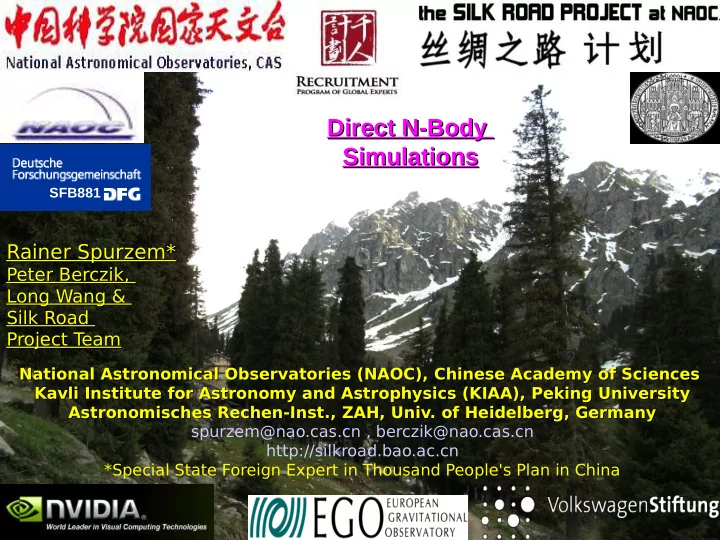

Direct N-Body Direct N-Body Simulations Simulations SFB881 Rainer Spurzem* Rainer Spurzem* Peter Berczik, Peter Berczik, Long Wang & Long Wang & Silk Road Silk Road Project T eam Project T eam National Astronomical Observatories (NAOC), Chinese Academy of Sciences National Astronomical Observatories (NAOC), Chinese Academy of Sciences Kavli Institute for Astronomy and Astrophysics (KIAA), Peking University Kavli Institute for Astronomy and Astrophysics (KIAA), Peking University Astronomisches Rechen-Inst., ZAH, Univ. of Heidelberg, Germany Astronomisches Rechen-Inst., ZAH, Univ. of Heidelberg, Germany spurzem@nao.cas.cn , berczik@nao.cas.cn http://silkroad.bao.ac.cn *Special State Foreign Expert in Thousand People's Plan in China
POSTER! Aspen Jan. 2015
Star Cluster Simulations – Key Issues Star Cluster Simulations – Key Issues Theoretical Models / Large N-Body Models Black Holes and Tidal Disruption/Star Accretion Accelerated Computing (GPU) Aspen Jan. 2015
Theoretical Modelling: Gas Sphere Theoretical Modelling: Gas Sphere Gravothermal Expansion! Gravothermal Expansion! Cohn (1980): Direct Fokker-Planckj model Core Collapse Gravothermal Catastrophe Bettwieser & Sugimoto 1984: Gravothermal Oscillations by energy generation from binaries (cf. nuclear stellar energy generation) Aspen Jan. 2015
Wang, , Sp,Aarseth+, Simulation ongoing. Sp.+Aarseth 1996 Slide originally from Douglas C. Heggie, Aspen Jan. 2015 citations added by RS
Direct Simulation (Poster Long Wang) Direct Simulation (Poster Long Wang) NBODY6++GPU 1 Million Bodies NBODY6++GPU 1 Million Bodies Wang, Spurzem, Aarseth, Berczik, Nitadori, Kouwenhoven, Naab 2015a subm. MNRAS, Wang et al. 2015b, in prep. Used RZG Garching hydra GPU cluster (400 Kepler GPUs) Aspen Jan. 2015
Preliminary Results N=256k star cluster 10% initial binaries Wang, Spurzem, Aarseth, Berczik,+ Left: initial HR diagram Right: after 2 Gyrs ...ongoing 1M ... Sorry! Problem with Plot of Binaries. .. work ongoing … Long Wang et al. Aspen Jan. 2015
Theoretical Modelling: Moment Models Theoretical Modelling: Moment Models 2011 Aspen Jan. 2015
MNRAS 2010 MNRAS 2010 MNRAS 2011 Aspen Jan. 2015
Downing et al. 2011 Aspen Jan. 2015
Theoretical Models II: Fokker-Planck Theoretical Models II: Fokker-Planck Orbit averaged Orbit averaged Fokker-Planck Fokker-Planck Equation Equation (here in the 2D (here in the 2D form for axisymm. form for axisymm. systems, systems, Einsel & Spurzem Einsel & Spurzem 1999) 1999) Aspen Jan. 2015
Theoretical Models II: Fokker-Planck Theoretical Models II: Fokker-Planck Kim, Yoon, Kim, Yoon, Dissolution of Star Cluster in Tidal Field Lee, Spurzem, Lee, Spurzem, 2008, MNRAS 2008, MNRAS spherical Hong, Kim, Hong, Kim, Lee, Spurzem, Lee, Spurzem, 2013, MNRAS 2013, MNRAS rotating Three Phases in Cluster Dissolution: 1) Core Collapse (Encounters) 2) Post-Collapse Steady Evaporation (Encount) 3) Dynamic final dissolution Aspen Jan. 2015
Star Cluster Simulations – Key Issues Star Cluster Simulations – Key Issues Theoretical Models / Large N-Body Models Black Holes and Tidal Disruption/Star Accretion Accelerated Computing (GPU) Aspen Jan. 2015
Theoretical Theoretical Models II: Models II: Fokker-Planck Fokker-Planck Fiestas, Preto, Berczik, Spurzem, Lee, 2015 in prep. Two Masses, Rotation, with and without black hole N-Body? Aspen Jan. 2015
Intermediate Mass Black Hole? The 1M body simulation: ← without IMBH Long, Spurzem, Aarseth, Berczik, Nitadori, Kouwenhoven, Naab, Fast mass segregation MNRAS 2015 in prep., now > 1Gyr Red line: average Stellar mass In inner shell With IMBH → Slow mass segregation Used RZG Garching hydra GPU cluster (400 Kepler GPUs) Aspen Jan. 2015
Tidal Disruption of Stars in Nuclear Star Clusters around SMBH Paper I: Spherical Models Large N-Body Simulations phiGPU (Zhong, Berczik, Spurzem 2014, ApJ) Using NAOC GPU Cluster (See also Standard 2-b relax. / empty loss cone (Frank/Rees 76) Li, Liu, Berczik, Chen, works extremely well, in spherical systems... Spurzem, 2012) Aspen Jan. 2015
Tidal Disruption of Stars in Nuclear Star Clusters around SMBH Paper II: Rotating Axisymmetric Models Zhong, Berczik, Bimodal Origin Spurzem, to be subm. of tidally accreted MNRAS Feb 2015 stars Moderately enhanced Loss cone Aspen Jan. 2015
Star-Disk Interactions enhance tidal accretion rate in star clusters with BH Just, ... Berczik, Spurzem, ..., 2012, ApJ (Paper I) Kennedy et al. 2015 in prep. (Paper II) Shukirgaliev et al. 2015 in prep. (Paper III) The presence of an accretion disk near an SMBH enhances the mass growth rate of SMBH by factor 3 and creates a stellar disk. With disk Shukirgaliev Without disk Et al. 2015 Aspen Jan. 2015
Star Cluster Simulations – Key Issues Star Cluster Simulations – Key Issues Theoretical Models / Large N-Body Models Black Holes and Tidal Disruption/Star Accretion Accelerated Computing (GPU) Aspen Jan. 2015
Top 10 List June 2012 Xeon ϕ ϕ Xeon GPU GPU Xeon ϕ ϕ Xeon Aspen Jan. 2015
(GPUs) Aspen Jan. 2015
NBODY6++GPU (Poster Long Wang) Wang et al. subm. MNRAS 2015 Aspen Jan. 2015
ΦGPU – NBODY Code 50% of peak 350 Teraflop/s 1600 GPUs . 440 cores = 704.000 GPU-Cores Strong and Soft Scaling In China... Using Mole-8.5 of IPE/CAS Beijing Spurzem et al, 2013, Lect. Notes Comp. Phys., Springer Aspen Jan. 2015
Summary/Future Astrophysical High Precision N-Body - Data Mining for million body simulations Rotation compare with theory Binaries, Collision Products Tidal Star Accretion with Black Hole Some More Astrophysical Science Drivers: GW Sources in Star Clusters / Gal. Nuclei No Evidence of Stalling of Binary Black Holes - Coalescence in 0.1 – 1.0 Gyrs in full simulation
Recommend
More recommend